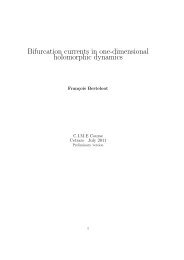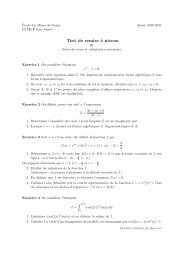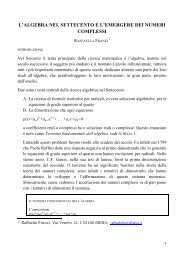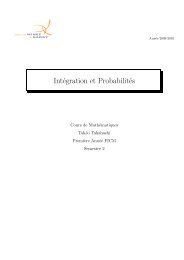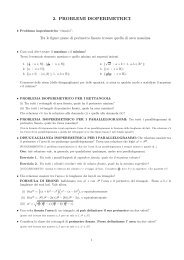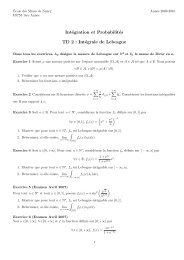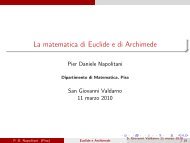Derivation of a fundamental diagram for urban traffic flow
Derivation of a fundamental diagram for urban traffic flow
Derivation of a fundamental diagram for urban traffic flow
Create successful ePaper yourself
Turn your PDF publications into a flip-book with our unique Google optimized e-Paper software.
6 The European Physical Journal B<br />
into (26) [andwithf i = f 0 i , T cyc = T 0 cyc ,seeEq.(33)],<br />
we get<br />
L i ρ av<br />
i (u i , {fj 0 av<br />
})=ΔNi (u i , {fj 0 })<br />
(1 − fi 0 = u i ̂Qi )2 Tcyc 0 ({f j 0})<br />
, (39)<br />
2(1 − u i )<br />
which finally yields<br />
u i (ρ av<br />
i L i , {f 0 j }) =<br />
(<br />
̂Q 1+(1− fi 0 ) 2 i Tcyc 0 ({f j 0})<br />
) −1<br />
2ρ av .<br />
i L i<br />
(40)<br />
Thiscanbeinsertedintoequation(26) togive<br />
Ti<br />
av (ρ av<br />
i L i , {fj 0 }) =<br />
u i (ρ av<br />
i<br />
ρ av<br />
i L i<br />
L i , {fj 0}) ̂Q i<br />
3.1 Transition to congested <strong>traffic</strong><br />
= ρav i L i<br />
+(1− f 0 T cyc({f 0<br />
i<br />
̂Q )2 j 0})<br />
. (41)<br />
i<br />
2<br />
The utilizations u i increase proportionally to the arrival<br />
<strong>flow</strong>s A i , i.e. they go up during the rush hour. Eventually,<br />
∑<br />
f j = ∑ (1 + δ j )u j → 1, (42)<br />
j<br />
j<br />
which means that the intersection capacity is reached.<br />
Sooner or later, there will be no excess capacities anymore,<br />
which implies δ i → 0andf i → u i .Inthiscase,<br />
we do not have any finite time periods ΔT i − T i , during<br />
which there are no delayed vehicles and where the departure<br />
<strong>flow</strong> O i (t) agrees with the arrival <strong>flow</strong> A i . There<strong>for</strong>e,<br />
O i (t) =γ i (t) ̂Q i according to equation (12), and certain relationships<br />
simplify. For example, the utilization is given<br />
as integral <strong>of</strong> the permeability over one cycle time T cyc ,<br />
divided by the cycle time itself:<br />
u i = 1<br />
T cyc<br />
t i0+T<br />
∫ cyc<br />
t i0<br />
dt ′ γ i (t ′ ). (43)<br />
Moreover, in the case <strong>of</strong> constant in- and out<strong>flow</strong>s, i.e. linear<br />
increase and decrease <strong>of</strong> the queue length, the average<br />
number ΔNi<br />
av <strong>of</strong> delayed vehicles is just given by half <strong>of</strong><br />
the maximum number <strong>of</strong> delayed vehicles 1<br />
ΔN av<br />
i<br />
=<br />
max<br />
ΔNi<br />
. (44)<br />
2<br />
1 Note that the <strong>for</strong>mulas derived in this paper are exact<br />
under the assumption <strong>of</strong> continuous <strong>flow</strong>s. The fact that<br />
vehicle <strong>flow</strong>s consist <strong>of</strong> discrete vehicles implies deviations<br />
from our <strong>for</strong>mulas <strong>of</strong> upto 1 vehicle, which slightly affects<br />
the average travel times as well. In Figure 2, <strong>for</strong> example,<br />
the number <strong>of</strong> vehicles in the queue is Ni<br />
max − 1 rather<br />
than Ni<br />
max . There<strong>for</strong>e, the related maximum delay time is<br />
(1 − u i)T cyc(Ni<br />
max − 1)/Ni<br />
max , which reduces the average delay<br />
time Ti<br />
av by (1 − u i)T cyc/(2Ni max ).<br />
As a consequence, we have<br />
T i ({u j })= L i<br />
V 0<br />
i<br />
+ (1 − u i)T los<br />
2 ( 1 − ∑ j u ). (45)<br />
j<br />
The average speed Vi<br />
av <strong>of</strong> <strong>traffic</strong> stream i is <strong>of</strong>ten determined<br />
by dividing the length L i <strong>of</strong> the road section reserved<br />
<strong>for</strong> it by the average travel time T i = Ti<br />
0 + Ti av ,<br />
which gives<br />
V av<br />
i ({u j })=<br />
(<br />
L i<br />
T i ({u j }) =<br />
1<br />
V 0<br />
i<br />
) −1<br />
+ (1 − u i)T los<br />
2L i (1 − ∑ j u ,<br />
j)<br />
(46)<br />
and can be generalized with equation (28) tocaseswith<br />
an efficiencies ɛ i ≠0:<br />
V av<br />
i ({u j },ɛ i )=<br />
(<br />
1<br />
V 0<br />
i<br />
) −1<br />
(1 − u i )T los<br />
+(1− ɛ i )<br />
2L i (1 − ∑ j u .<br />
j)<br />
(47)<br />
Note, however, that the above <strong>for</strong>mulas <strong>for</strong> the average<br />
speed are implicitly based on a harmonic rather than<br />
an arithmetic average. When correcting <strong>for</strong> this, equation<br />
(46), <strong>for</strong> example, becomes<br />
V av<br />
i ({u j })=<br />
∣<br />
L i u i ̂Qi ∣∣∣∣<br />
({u j }) ln 1+<br />
ΔN max<br />
i<br />
ΔN<br />
max<br />
i ({u j })<br />
u i ̂Qi T 0<br />
i<br />
∣ . (48)<br />
As is shown in Appendix A, this has a similar Taylor approximation<br />
as the harmonic average (47). The latter is<br />
there<strong>for</strong>e reasonable to use, and it is simpler to calculate.<br />
As expected from queuing theory, the average travel<br />
time (45) diverges, when the sum <strong>of</strong> utilizations reaches<br />
the intersection capacity, i.e. ∑ j u j → 1. In this practically<br />
relevant case, the <strong>traffic</strong> light would not switch anymore,<br />
which would frustrate drivers. For this reason, the<br />
cycle time is limited to a finite value<br />
T max<br />
cyc ({u0 j })=<br />
T los<br />
1 − ∑ , (49)<br />
j u0 j<br />
where typically u 0 j ≤ u j. This implies that the sum <strong>of</strong><br />
utilizations must fulfill<br />
∑<br />
u j ≤ ∑ u 0 j =1− T los<br />
T max . (50)<br />
j<br />
j<br />
cyc<br />
As soon as this condition is violated, we will have an increase<br />
<strong>of</strong> the average number <strong>of</strong> delayed vehicles in time,<br />
which characterizes the congested regime discussed in the<br />
next section.<br />
4 Fundamental relationships <strong>for</strong> congested<br />
<strong>traffic</strong> conditions<br />
In the congested regime, the number <strong>of</strong> delayed vehicles<br />
does not reach zero anymore, and platoons cannot<br />
be served without delay. Vehicles will usually have to



